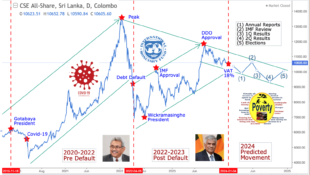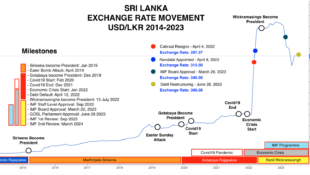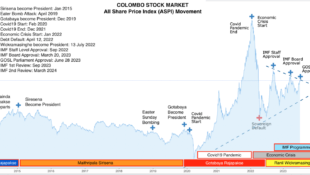Sri Lanka is the world’s second-best performing economy in the world after China, we are told.
According to Economic Development Minister Basil Rajapaksa, an IMF study has showed that Sri Lanka was the second-best performing economy in the world, growing at a rate of over 8 %. He also told reporters this week that Sri Lanka is growing this year by 8 % when other countries have reduced growth rates.
However many economists, following these comments, have been ‘Googling’ the web but unable to trace any such report or study from the International Monetary Fund. IMF officials here were also unable to provide any clues to this so-called study.
On the face of it however, Sri Lanka’s GDP growth is comparable to the best in the world. According to the tradingeconomics website (www.tradingeconomics.com), China, which by 2050 will overtake the US as the world’s largest economy, grew by 8.9 % in 2011 and India by 6.9 %. Others – mostly Sri Lanka’s main buyers of garments and other products – slowed down considerably with Canada’s growth being 3.4%, Germany-Australia-France in the 2 to 2.5% range while the US grew by 1.5 % and the UK by a marginal 0.7%.
Qatar on the other hand grew by over 30 % average in the first three quarters of 2011 while Argentina’s GDP’s was also over 9 % and Turkey at 8.2 %, slightly lower than Sri Lanka. So would this make Sri Lanka the fourth-best performing economy (after Qatar, Argentina, China and Turkey)?
Figures however can be deceptive since for all its growth statistics proudly touted by the government, there are serious economic management issues, problems that have been raised repeatedly in these columns and also by the Sunday Times’ columnist on economic issues, Dr deleted Sanderatne.
Credit however must be given to Governments during the 30 years of conflict for continuing basic services like health, education and food needs in the North and East even in areas that were controlled by the LTTE. In some countries which also faced similr raging conflicts, supplies were either cut off or reduced to cripple militant groups but which ultimately affected civilians.
The sustenance of basic public services and Sri Lankans being resilient enough to sustain an economy and quickly adjust to a post-war situation is what led to the conflict-areas being able to grow faster than in any other country that recovered from a conflict. The same applies to the national economy where the service sector, particularly services (telecommunications and tourism) responded quickly.
Yet in terms of growth, are we just papering the economic cracks and lulling the population into a false sense of belief that everything is hunky-dory?
Take for example the main conditions on which the IMF’s $2.6 billion bail-out package was given in July 2009: reducing public debt to GDP ratio, the Ceylon Petroleum Corporation and the Ceylon Electricity Board breaking even by end 2011, and a flexible exchange rate policy. None of these has been fulfilled, according to economists. Exchange rates are managed by the Central Bank and not pegged to the market leading to President Mahinda Rajapaksa announcing 3 % devaluation in the last budget following concerns raised by exporters. While this was relief to exporters, it has caused uncertainty in the money markets with a ‘will-the-Treasury-intervene-again’ kind of perception. Interest rates are also not in line with market trends.
Problems persist. The spat between the Treasury chief Dr P.B. Jayasundera and Central Bank Governor Ajith Nivard Cabraal, sometimes spilling out in public, has unnerved investors. Both institutions need to work together not against each other as seen with figures on the national economy being contested by either party.
The disastrous expropriation bill, the deadly pension bill and the conduct of examinations were all issues. Badgering the media for not reporting their views (Government) and those views alone without objectivity is not the answer to an economy that is best-performing where many of the underlying problems are either covered up or hidden from the glare of the public.
Government deals are repeatedly under question and unconvincing answers bordering on arrogance, provided. The main growth sectors are services and construction and dependence on remittances from Middle East migrant workers while agriculture (although production has improved in the North and the East) and industries are yet to take off.
In the real economy, people are not feeling the benefits of this growth. Cost of living is rising.
Opposition legislator Eran Wickremaratne raised a valid point, recently. Speaking at a Colombo discussion on the ‘economic perspective in post-war reconciliation’, he said while there should have been a grand recovery plan for the conflict areas, a Marshall (like) Plan happened in the South with a new cricket stadium convention centre, airport and seaport.
“Such a development should have taken place in the North or at least in both regions,” he said, adding that the ‘Feel Good factor’ is being promoted vigorously while oil pricing are going up and debts (national and people’s) are rising. There are huge challenges in law and order, governance, transparency and accountability.
Militarization of the economy, he says is similar to what happens in China and Pakistan.
That’s true - the Army in setting up a commercial company to handle private contracts, the Navy is ferrying tourists on whale and dolphin watching tours and the Air Force has a commercial flying service to Jaffna.
An economy must take in all these social, economic and political factors into consideration in its growth path. Being pleased and, on the other, complacent by positive growth figures is not going to help anyone, mainly the people of Sri Lanka.
http://sundaytimes.lk/120129/BusinessTimes/bt07.html
 would enable you to enjoy an array of other services such as Member Rankings, User Groups, Own Posts & Profile, Exclusive Research, Live Chat Box etc..
would enable you to enjoy an array of other services such as Member Rankings, User Groups, Own Posts & Profile, Exclusive Research, Live Chat Box etc.. 
 Home
Home